Qiong Yan
Modeling Dual-Exposure Quad-Bayer Patterns for Joint Denoising and Deblurring
Dec 10, 2024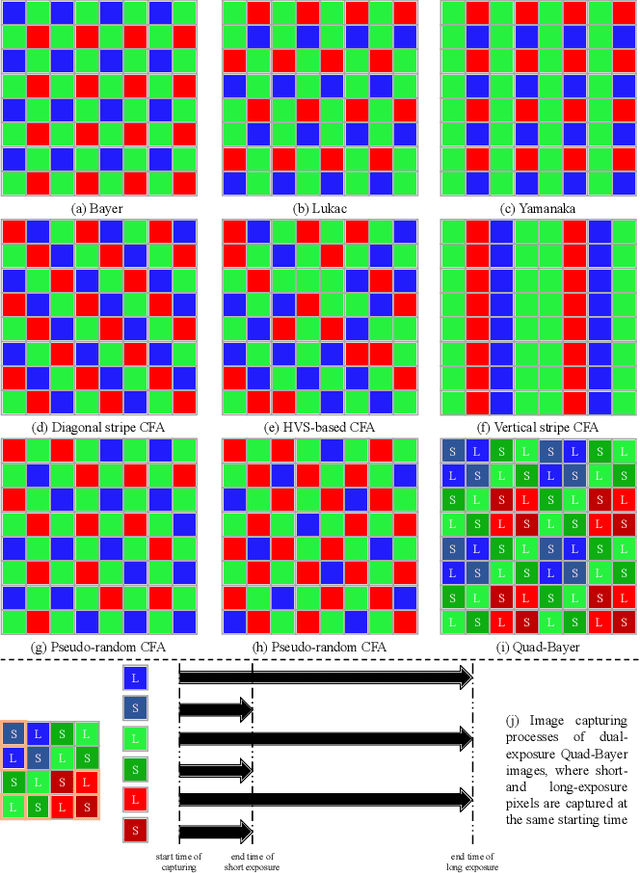


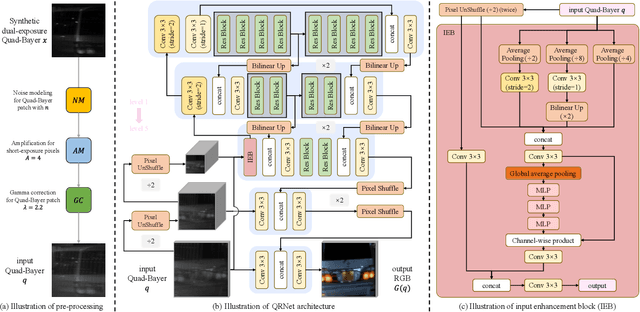
Abstract:Image degradation caused by noise and blur remains a persistent challenge in imaging systems, stemming from limitations in both hardware and methodology. Single-image solutions face an inherent tradeoff between noise reduction and motion blur. While short exposures can capture clear motion, they suffer from noise amplification. Long exposures reduce noise but introduce blur. Learning-based single-image enhancers tend to be over-smooth due to the limited information. Multi-image solutions using burst mode avoid this tradeoff by capturing more spatial-temporal information but often struggle with misalignment from camera/scene motion. To address these limitations, we propose a physical-model-based image restoration approach leveraging a novel dual-exposure Quad-Bayer pattern sensor. By capturing pairs of short and long exposures at the same starting point but with varying durations, this method integrates complementary noise-blur information within a single image. We further introduce a Quad-Bayer synthesis method (B2QB) to simulate sensor data from Bayer patterns to facilitate training. Based on this dual-exposure sensor model, we design a hierarchical convolutional neural network called QRNet to recover high-quality RGB images. The network incorporates input enhancement blocks and multi-level feature extraction to improve restoration quality. Experiments demonstrate superior performance over state-of-the-art deblurring and denoising methods on both synthetic and real-world datasets. The code, model, and datasets are publicly available at https://github.com/zhaoyuzhi/QRNet.
Q-Ground: Image Quality Grounding with Large Multi-modality Models
Jul 24, 2024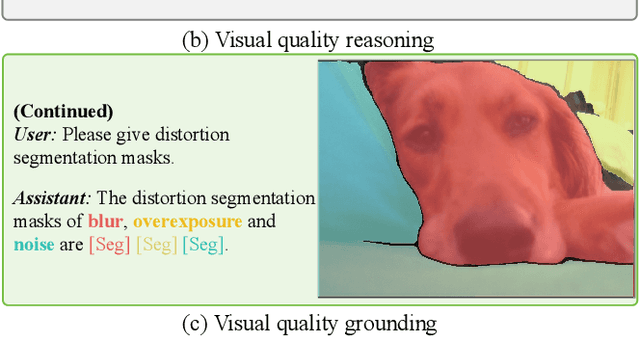



Abstract:Recent advances of large multi-modality models (LMM) have greatly improved the ability of image quality assessment (IQA) method to evaluate and explain the quality of visual content. However, these advancements are mostly focused on overall quality assessment, and the detailed examination of local quality, which is crucial for comprehensive visual understanding, is still largely unexplored. In this work, we introduce Q-Ground, the first framework aimed at tackling fine-scale visual quality grounding by combining large multi-modality models with detailed visual quality analysis. Central to our contribution is the introduction of the QGround-100K dataset, a novel resource containing 100k triplets of (image, quality text, distortion segmentation) to facilitate deep investigations into visual quality. The dataset comprises two parts: one with human-labeled annotations for accurate quality assessment, and another labeled automatically by LMMs such as GPT4V, which helps improve the robustness of model training while also reducing the costs of data collection. With the QGround-100K dataset, we propose a LMM-based method equipped with multi-scale feature learning to learn models capable of performing both image quality answering and distortion segmentation based on text prompts. This dual-capability approach not only refines the model's understanding of region-aware image quality but also enables it to interactively respond to complex, text-based queries about image quality and specific distortions. Q-Ground takes a step towards sophisticated visual quality analysis in a finer scale, establishing a new benchmark for future research in the area. Codes and dataset are available at https://github.com/Q-Future/Q-Ground.
Towards Open-ended Visual Quality Comparison
Mar 04, 2024Abstract:Comparative settings (e.g. pairwise choice, listwise ranking) have been adopted by a wide range of subjective studies for image quality assessment (IQA), as it inherently standardizes the evaluation criteria across different observers and offer more clear-cut responses. In this work, we extend the edge of emerging large multi-modality models (LMMs) to further advance visual quality comparison into open-ended settings, that 1) can respond to open-range questions on quality comparison; 2) can provide detailed reasonings beyond direct answers. To this end, we propose the Co-Instruct. To train this first-of-its-kind open-source open-ended visual quality comparer, we collect the Co-Instruct-562K dataset, from two sources: (a) LLM-merged single image quality description, (b) GPT-4V "teacher" responses on unlabeled data. Furthermore, to better evaluate this setting, we propose the MICBench, the first benchmark on multi-image comparison for LMMs. We demonstrate that Co-Instruct not only achieves in average 30% higher accuracy than state-of-the-art open-source LMMs, but also outperforms GPT-4V (its teacher), on both existing related benchmarks and the proposed MICBench. Our model is published at https://huggingface.co/q-future/co-instruct.
Q-Align: Teaching LMMs for Visual Scoring via Discrete Text-Defined Levels
Dec 28, 2023



Abstract:The explosion of visual content available online underscores the requirement for an accurate machine assessor to robustly evaluate scores across diverse types of visual contents. While recent studies have demonstrated the exceptional potentials of large multi-modality models (LMMs) on a wide range of related fields, in this work, we explore how to teach them for visual rating aligned with human opinions. Observing that human raters only learn and judge discrete text-defined levels in subjective studies, we propose to emulate this subjective process and teach LMMs with text-defined rating levels instead of scores. The proposed Q-Align achieves state-of-the-art performance on image quality assessment (IQA), image aesthetic assessment (IAA), as well as video quality assessment (VQA) tasks under the original LMM structure. With the syllabus, we further unify the three tasks into one model, termed the OneAlign. In our experiments, we demonstrate the advantage of the discrete-level-based syllabus over direct-score-based variants for LMMs. Our code and the pre-trained weights are released at https://github.com/Q-Future/Q-Align.
Iterative Token Evaluation and Refinement for Real-World Super-Resolution
Dec 09, 2023


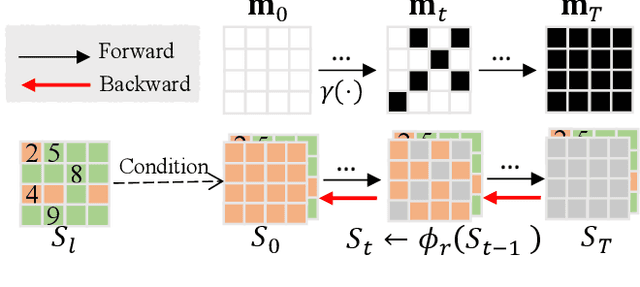
Abstract:Real-world image super-resolution (RWSR) is a long-standing problem as low-quality (LQ) images often have complex and unidentified degradations. Existing methods such as Generative Adversarial Networks (GANs) or continuous diffusion models present their own issues including GANs being difficult to train while continuous diffusion models requiring numerous inference steps. In this paper, we propose an Iterative Token Evaluation and Refinement (ITER) framework for RWSR, which utilizes a discrete diffusion model operating in the discrete token representation space, i.e., indexes of features extracted from a VQGAN codebook pre-trained with high-quality (HQ) images. We show that ITER is easier to train than GANs and more efficient than continuous diffusion models. Specifically, we divide RWSR into two sub-tasks, i.e., distortion removal and texture generation. Distortion removal involves simple HQ token prediction with LQ images, while texture generation uses a discrete diffusion model to iteratively refine the distortion removal output with a token refinement network. In particular, we propose to include a token evaluation network in the discrete diffusion process. It learns to evaluate which tokens are good restorations and helps to improve the iterative refinement results. Moreover, the evaluation network can first check status of the distortion removal output and then adaptively select total refinement steps needed, thereby maintaining a good balance between distortion removal and texture generation. Extensive experimental results show that ITER is easy to train and performs well within just 8 iterative steps. Our codes will be available publicly.
Enhancing Diffusion Models with Text-Encoder Reinforcement Learning
Nov 27, 2023
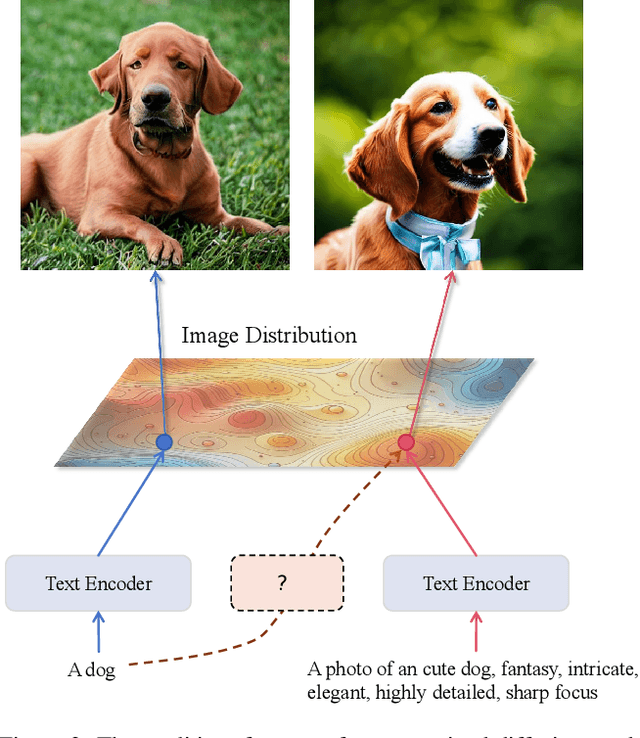
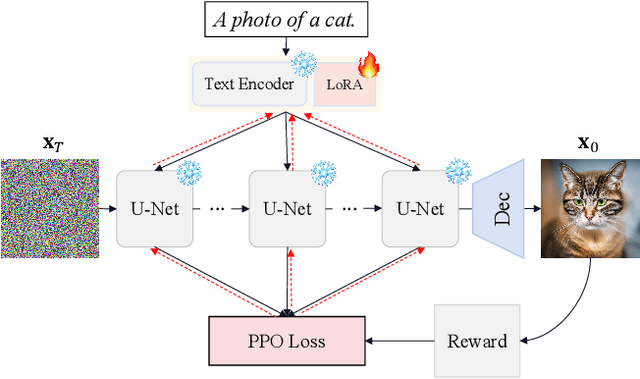

Abstract:Text-to-image diffusion models are typically trained to optimize the log-likelihood objective, which presents challenges in meeting specific requirements for downstream tasks, such as image aesthetics and image-text alignment. Recent research addresses this issue by refining the diffusion U-Net using human rewards through reinforcement learning or direct backpropagation. However, many of them overlook the importance of the text encoder, which is typically pretrained and fixed during training. In this paper, we demonstrate that by finetuning the text encoder through reinforcement learning, we can enhance the text-image alignment of the results, thereby improving the visual quality. Our primary motivation comes from the observation that the current text encoder is suboptimal, often requiring careful prompt adjustment. While fine-tuning the U-Net can partially improve performance, it remains suffering from the suboptimal text encoder. Therefore, we propose to use reinforcement learning with low-rank adaptation to finetune the text encoder based on task-specific rewards, referred as \textbf{TexForce}. We first show that finetuning the text encoder can improve the performance of diffusion models. Then, we illustrate that TexForce can be simply combined with existing U-Net finetuned models to get much better results without additional training. Finally, we showcase the adaptability of our method in diverse applications, including the generation of high-quality face and hand images.
Q-Instruct: Improving Low-level Visual Abilities for Multi-modality Foundation Models
Nov 12, 2023



Abstract:Multi-modality foundation models, as represented by GPT-4V, have brought a new paradigm for low-level visual perception and understanding tasks, that can respond to a broad range of natural human instructions in a model. While existing foundation models have shown exciting potentials on low-level visual tasks, their related abilities are still preliminary and need to be improved. In order to enhance these models, we conduct a large-scale subjective experiment collecting a vast number of real human feedbacks on low-level vision. Each feedback follows a pathway that starts with a detailed description on the low-level visual appearance (*e.g. clarity, color, brightness* of an image, and ends with an overall conclusion, with an average length of 45 words. The constructed **Q-Pathway** dataset includes 58K detailed human feedbacks on 18,973 images with diverse low-level appearance. Moreover, to enable foundation models to robustly respond to diverse types of questions, we design a GPT-participated conversion to process these feedbacks into diverse-format 200K instruction-response pairs. Experimental results indicate that the **Q-Instruct** consistently elevates low-level perception and understanding abilities across several foundational models. We anticipate that our datasets can pave the way for a future that general intelligence can perceive, understand low-level visual appearance and evaluate visual quality like a human. Our dataset, model zoo, and demo is published at: https://q-future.github.io/Q-Instruct.
Q-Bench: A Benchmark for General-Purpose Foundation Models on Low-level Vision
Sep 28, 2023Abstract:The rapid evolution of Multi-modality Large Language Models (MLLMs) has catalyzed a shift in computer vision from specialized models to general-purpose foundation models. Nevertheless, there is still an inadequacy in assessing the abilities of MLLMs on low-level visual perception and understanding. To address this gap, we present Q-Bench, a holistic benchmark crafted to systematically evaluate potential abilities of MLLMs on three realms: low-level visual perception, low-level visual description, and overall visual quality assessment. a) To evaluate the low-level perception ability, we construct the LLVisionQA dataset, consisting of 2,990 diverse-sourced images, each equipped with a human-asked question focusing on its low-level attributes. We then measure the correctness of MLLMs on answering these questions. b) To examine the description ability of MLLMs on low-level information, we propose the LLDescribe dataset consisting of long expert-labelled golden low-level text descriptions on 499 images, and a GPT-involved comparison pipeline between outputs of MLLMs and the golden descriptions. c) Besides these two tasks, we further measure their visual quality assessment ability to align with human opinion scores. Specifically, we design a softmax-based strategy that enables MLLMs to predict quantifiable quality scores, and evaluate them on various existing image quality assessment (IQA) datasets. Our evaluation across the three abilities confirms that MLLMs possess preliminary low-level visual skills. However, these skills are still unstable and relatively imprecise, indicating the need for specific enhancements on MLLMs towards these abilities. We hope that our benchmark can encourage the research community to delve deeper to discover and enhance these untapped potentials of MLLMs. Project Page: https://vqassessment.github.io/Q-Bench.
Local Distortion Aware Efficient Transformer Adaptation for Image Quality Assessment
Aug 23, 2023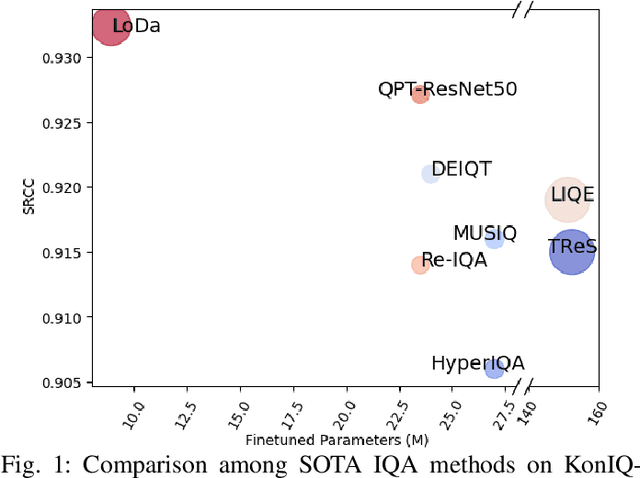
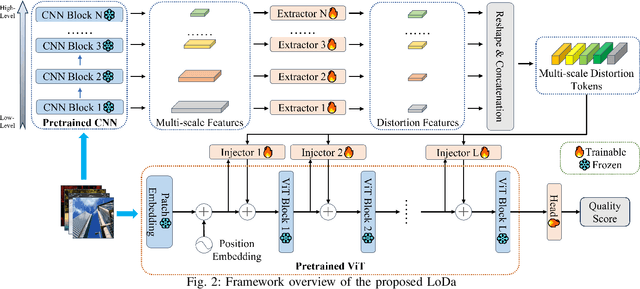
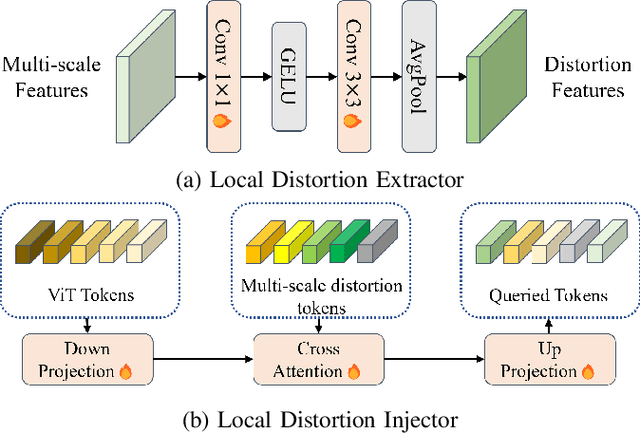
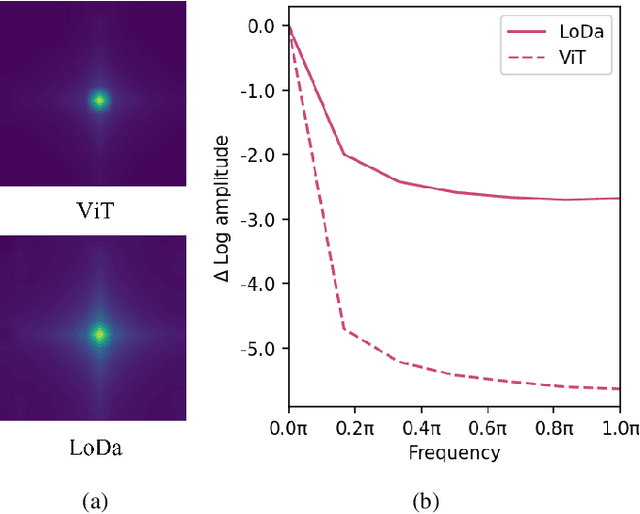
Abstract:Image Quality Assessment (IQA) constitutes a fundamental task within the field of computer vision, yet it remains an unresolved challenge, owing to the intricate distortion conditions, diverse image contents, and limited availability of data. Recently, the community has witnessed the emergence of numerous large-scale pretrained foundation models, which greatly benefit from dramatically increased data and parameter capacities. However, it remains an open problem whether the scaling law in high-level tasks is also applicable to IQA task which is closely related to low-level clues. In this paper, we demonstrate that with proper injection of local distortion features, a larger pretrained and fixed foundation model performs better in IQA tasks. Specifically, for the lack of local distortion structure and inductive bias of vision transformer (ViT), alongside the large-scale pretrained ViT, we use another pretrained convolution neural network (CNN), which is well known for capturing the local structure, to extract multi-scale image features. Further, we propose a local distortion extractor to obtain local distortion features from the pretrained CNN and a local distortion injector to inject the local distortion features into ViT. By only training the extractor and injector, our method can benefit from the rich knowledge in the powerful foundation models and achieve state-of-the-art performance on popular IQA datasets, indicating that IQA is not only a low-level problem but also benefits from stronger high-level features drawn from large-scale pretrained models.
TOPIQ: A Top-down Approach from Semantics to Distortions for Image Quality Assessment
Aug 06, 2023



Abstract:Image Quality Assessment (IQA) is a fundamental task in computer vision that has witnessed remarkable progress with deep neural networks. Inspired by the characteristics of the human visual system, existing methods typically use a combination of global and local representations (\ie, multi-scale features) to achieve superior performance. However, most of them adopt simple linear fusion of multi-scale features, and neglect their possibly complex relationship and interaction. In contrast, humans typically first form a global impression to locate important regions and then focus on local details in those regions. We therefore propose a top-down approach that uses high-level semantics to guide the IQA network to focus on semantically important local distortion regions, named as \emph{TOPIQ}. Our approach to IQA involves the design of a heuristic coarse-to-fine network (CFANet) that leverages multi-scale features and progressively propagates multi-level semantic information to low-level representations in a top-down manner. A key component of our approach is the proposed cross-scale attention mechanism, which calculates attention maps for lower level features guided by higher level features. This mechanism emphasizes active semantic regions for low-level distortions, thereby improving performance. CFANet can be used for both Full-Reference (FR) and No-Reference (NR) IQA. We use ResNet50 as its backbone and demonstrate that CFANet achieves better or competitive performance on most public FR and NR benchmarks compared with state-of-the-art methods based on vision transformers, while being much more efficient (with only ${\sim}13\%$ FLOPS of the current best FR method). Codes are released at \url{https://github.com/chaofengc/IQA-PyTorch}.
 Add to Chrome
Add to Chrome Add to Firefox
Add to Firefox Add to Edge
Add to Edge